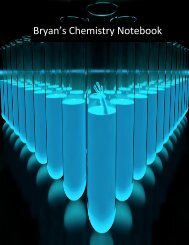Create successful ePaper yourself
Turn your PDF publications into a flip-book with our unique Google optimized e-Paper software.
Electrolytes and Nonelectrolytes- An electrolyte 7 is a compound that conducts an electric<br />
current when it is an aqueous solution or in the molten core. Conduction of an electric current<br />
requires ions that are mobile and, thus, able to carry charges through a liquid. All ionic compounds<br />
are electrolytes because they dissociate into ions. Barium sulfate is an ionic compound that cannot<br />
conduct an electric current in aqueous solution because it is insoluble, but it can conduct in the<br />
molten core. A nonelectrolyte 8 is a compound that does not conduct an electric current in either an<br />
aqueous solution or the molten state. Many molecular compounds are nonelectrolytes because they<br />
are not composed of ions. Most compounds of carbon, such as table sugar and the alcohol in rubbing<br />
alcohol, are nonelectrolytes. In a solution that contains a strong electrolyte 9 , all or nearly all of the<br />
solute exists as ions. The ions move in solution and conduct an electric current. Most soluble salts,<br />
inorganic acids, and inorganic bases are strong electrolytes. A weak electrolyte 10 conducts an<br />
electric current poorly because only a fraction of the solute in the solution exists as ions. Organic<br />
acids and bases are also examples of weak electrolytes.<br />
Hydrates- The water contained in a crystal is called the water of hydration 11 or water of<br />
crystallization. A compound that contains water of hydration is called a hydrate 12 . A substance that is<br />
anhydrous 13 does not contain water. If a hydrate has a pressure higher than the pressure of water<br />
vapor in the air, the hydrate will lose its water of hydration or effloresce 14 . These hydrates and other<br />
compounds that remove moisture from air called hygroscopic 15 . A desiccant 16 is a substance used to<br />
absorb moisture from the air and create a dry atmosphere. These compounds are deliquescent 17 ,<br />
which means that they remove sufficient water from air to dissolve completely and form solutions.<br />
The forces holding the water molecules in hydrates are not very strong, so the water is easily lost and<br />
regained.<br />
15.3 Heterogeneous Aqueous Systems<br />
Suspensions- In contrast, heterogeneous mixtures are not solutions. A suspension 18 is a mixture<br />
from which particles settle out upon standing. A suspension differs from a solution because the<br />
particles of a suspension are much larger and do not stay suspended indefinitely. Suspensions are<br />
heterogeneous because at least two substances can be clearly identified.<br />
Colloids- A colloid 19 is a heterogeneous mixture containing particles that range in size from 1 nm to<br />
1000nm. The particles are spread, or dispersed, throughout the dispersion medium, which can be<br />
solid, liquid, or gas. The scattering of visible light by colloidal particles is called the Tyndall effect 20 .<br />
The chaotic movement of colloidal particles, which was first observed by the Scottish botanist Robert<br />
Brown (1773-1858), is called Brownian motion 21 . An emulsion 22 is a colloidal dispersion of a liquid in<br />
a liquid. Colloids have particles smaller than those in suspensions and larger than lose in solutions.<br />
Many colloids are cloudy or milky in appearance, like suspensions, when they are concentrated.<br />
Colloids may look clear or almost clear, like solutions, when they are diluted. The important difference<br />
between colloids and solutions and suspensions is in the size of the particles. The first substances to<br />
be identified as a colloid was glue. Other substances that were also colloids were paint, aerosol<br />
spray, and smoke.<br />
125




